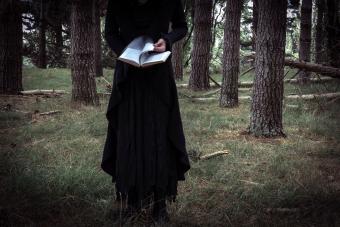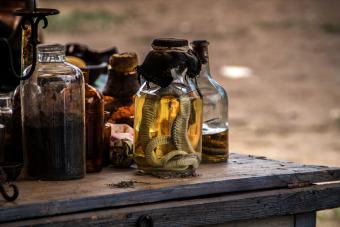
Each type of folk magic has specific traditions, rituals, practices, and often spellwork. Some folk magic practices are cultural-based, while others are regional. Compare some of the most common practices as you learn more about them.
A Simple Explanation of Folk Magic
Folk magic is a blend of holistic healing traditions that has evolved over time, often centuries, among cultures and communities. It blends the ancient knowledge of earth, nature energies, planetary forces, rituals, healing and herbal remedies, religious and superstitious beliefs, and a wide range of regional custom practices.
Folk Magic Practitioners
Folk magic can be practiced by just about anyone who is devoted to learning more about the old ways and integrating them into modern life. However, it pays to know that certain folk magic traditions are closed or guarded practices, meaning practices that really should only be undertaken by those who are either initiated into them, or born into them. Examples of these include indigenous folk practices and any diasporic folk magic (hoodoo generally falls under this category, for example.)
Folk magic used to be handed down through the generations, but as people moved away from magical knowledge, those lines became blurred or broken, and many people are now trying to re-establish ties with the folk magic of their cultures.

Types of Folk Magic
Since folk magic varies by culture, there are many types. Look to your lineage for inspiration about where to begin. In addition to the traditions below, look into Italian folk magic, Slavic folk magic, or any other magic inherent in a culture.
Appalachian Folk Magic
Appalachian folk magic was also known as Granny Magic in honor of the Granny Women who served as the caregivers to their communities. These women served as the community's doctor and midwife.
The Granny Women used a combination of herbs, faith and magic. However, Granny Women didn't view their work as magic, but as healing arts. If you had a headache, they might apply salt to your head to draw out the pain. A tea mixed with whiskey would be rubbed on a baby's gums for relief from teething. A burn might be treated by fanning smoke over the burn along with a short incantation.
The practices were a mix of folk medicine, usually herbal and ancient folk magic, often with Celtic origins.

Brujeria
Brujeria is practiced by those in Latin-American and Afro-Caribbean cultures. It's a practice that is influenced and informed by both indigenous tradition and Catholicism, and includes both "white" and "black" magic. Brujeria can be traced back to the 1500s, and continues to the present day, gaining a resurgence as younger generations rediscover the folk magic of their cultures. Practitioners of brujeria place very strong belief in spirits, asking them for advice and guidance and honoring them as an integral part of their practice.
Cunning Folk
The roots of the Cunning Folk date back to the Dark Ages. Cunning Folk were mostly involved in healing magic and remedy magic for curses or undertook exposing evil ones who hexed unsuspecting folks.
The ancient magical secrets the Cunning Folk used were passed down from one generation to the next. The magic practices consisted of rituals, incantations, spellwork, and other magic practices.
Hoodoo Folk Magic
Hoodoo evolved from the merging of various practices of African slaves from Nigeria, the Congo and other regions who lived in the American Deep South states, such as Louisiana. It is a magic combination of conjuring, rootwork and witchcraft. Hoodoo shouldn't be confused with the religion of Voodoo. Hoodoo is practiced around the world.
Hoodoo practitioners use all kinds of tools in magic rituals, such as herbs, powders, stones, roots, coins, and various preserved animal parts. Conjurers use Mojo bags that contain specific items for each spell. Even human fingernails, hair and blood are used in spells that target individuals.
This is a practice that is considered guarded or closed in many circles.

Ozark Folk Magic
From the Ozarks in Missouri and northern Arkansas, Ozark Folk Magic reflects the diversity of cultures that include Gaelic, Celtic, Native American and German. Some of the practices are similar to Appalachian Folk Magic, but there are quite a few different types of magic and superstitions reflective of the Ozark people's heritage. Ozark Magic and Folklore provides a look into the everyday life in the Ozarks.
Ozark folk magic practitioners practice certain types of divination, such as reading the lines and patterns in eggshells. Verbal charms are silent prayers or phrases never spoken out loud since this would take away their power.
Pow-Wow Folk Magic
Pennsylvania Dutch, such as the Amish, Mennonites and Dunkers, are often part of the Pow-wow Folk magic. This type of magic is used mostly for protection and healings. Pow-wow practitioners recite incantations that are mostly from the Bible.
John George Hohman is credited with Pow-wow magic having written a book titled Pow-Wows, or Long Lost Friend, featuring Ozark spells and charms. The majority of Pow-Wow Folk Magic is Christian based. Pow-Wow practitioners carry a Bible to use passages for healings and casting spells. They also use sigils, although they call them hex signs, symbols of protection that are drawn on the sides of barns and other buildings. Also, in the mix are various texts and beliefs from Urglaawe, a German pagan religion.

Different Traditions, Practices and Types of Folk Magic
There are many types of folk magic practices you can explore. Many of the traditions have similar roots and share some rituals and superstitions.







